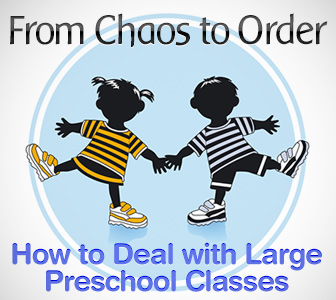From Chaos to Order – How to Deal with Large Preschool Classes


Ideally your classroom will be an area in which everyone can participate and students listen respectfully to one another. Let’s talk about some ways to achieve this.
Class Activities
For activities that are being done as a class such as checking homework, a student wishing to speak should raise his hand rather than call out. This is a common rule in classrooms around the world but some students easily forget this basic guideline. If you reward students for volunteering answers, simply say that answers that are shouted out will not count towards their participation points and that they have to take turns and respect one another. This should help encourage students to raise their hands. Some more tips on teaching large groups can be found here: ‘How To Teach Large Groups: The More The Merrier?’
If you are doing a team activity where everyone is working frantically and loudly with their teams members, consider having a bell or some other noisemaker so that you can save your voice when signaling the end of the activity. You can only shout “Go back to your seats!” so many times before your voice gives out and there is no need to strain yourself. It is fun to do these types of activities so you just have to have a plan for dealing with the noise. Choose something and stick with it so that students can become used to your chosen system of communication.
When doing loud activities consider the classes around you too. If you think your students may be so loud that other classes will be affect make a different lesson plan, change the activity, try to meet in another location, or at the very least ensure that those other classes will not be taking exams and tell your students at the beginning of the activity that they should keep it down. It could be that the majority of your classes have absolutely no problem with volume while one just goes absolutely crazy. Remember this next time you want to do a similar activity.
Group Work & Pair Work
When students are working in groups or in pairs, they should keep their voices at a normal level. You may want your students to be interested in learning English but, with the exceptions of performing role plays, students are usually not going to be so overly enthusiastic that they must raise their voices. Remind students that there are other people working and that you have to be able to hear learners who are practicing. Some role plays will require more emotion and volume variation based on the situation you are working with. Even your students that are enthusiastic actors should keep themselves in check. If you find yourself repeatedly telling a small number of students to take it down a notch, speak with them outside of class to address their disruptive behavior.
Individual Work
When students are working individually they are usually not doing speaking exercises and therefore should be working silently. Unless students are asking a question or responding to feedback you have given them, the class should be relatively quiet. Put your classroom management and discipline skills to work if students insist on being distracting during these times.
Tips
Set up rules. From your very first day in the classroom you should establish some ground rules. If you allow students to behave a certain way for the first month you are at their school, it will be nearly impossible to change their behavior later. From the beginning ensure that students who wish to speak raise their hands and that students maintain an appropriate volume when speaking and completing activities. You can even post these rules on the wall of your classroom to refer to when necessary.
When a student or group of students will not stop talking to one another while you are speaking, just stop teaching for a minute. Let them see that you notice them, ask these students if they understand the material or have questions. Ask them to rephrase what you were saying to see if they were listening. Point out to them that students should not be talking while you are talking and that their peers are being deprived of an education because of their disrespectful behavior. If students do not stop after several warnings, take some disciplinary action. This will vary depending on your school.
If you know that your students are especially loud, plan activities that require them to be quiet such as Chinese Whispers. This will maintain a low level of noise in the classroom and prevent you from disrupting the surrounding classes.
When you are showing students videos or listening to music, turn the volume down to begin with and then find an appropriate level once the material has started playing. This will keep something from starting out excessively loud.
Large classes are especially difficult to manage simply because so many people are contributing to the overall volume in the room. Forty people speaking at a normal volume are still going to make a lot of noise. Thinking about the different situations and tips above can help you tackle this issue with your students.